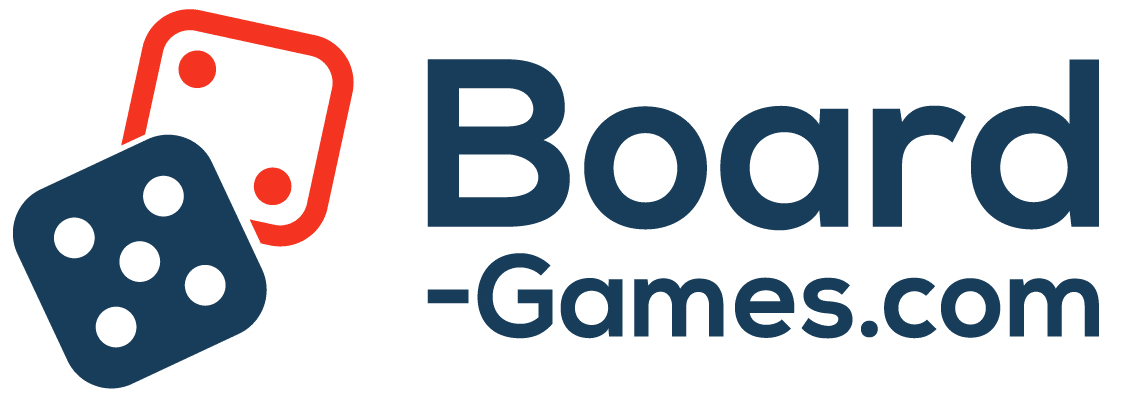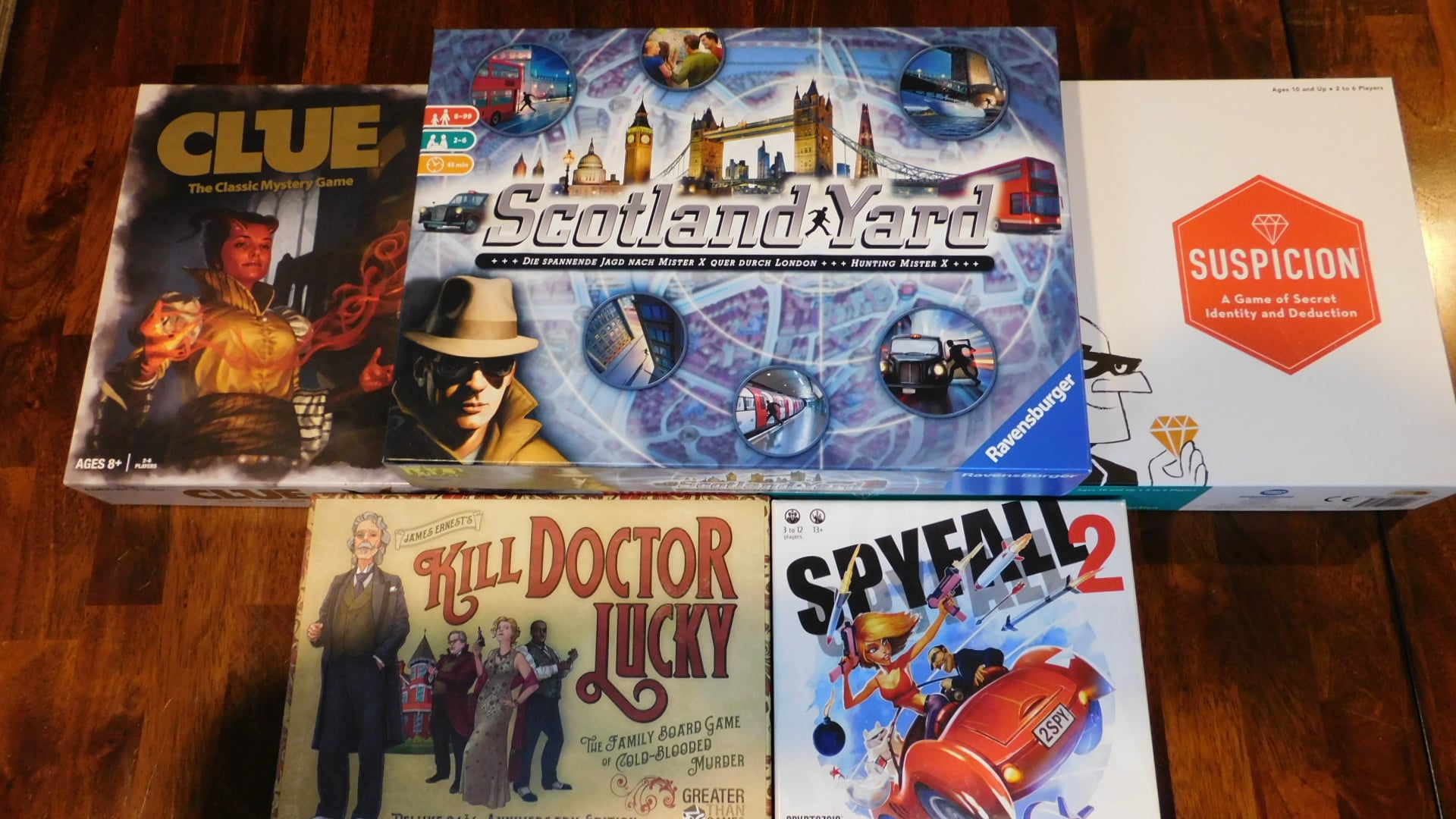Clue is a classic board game that’s been around since 1949. Since then many more board games have come out, including some that are like Clue. So, if you’re looking for 5 board games like Clue, we’ve got you covered.
5 board games like Clue are Suspicion, Kill Doctor Lucky, Scotland Yard, Spyfall, and other versions of Clue.
Table of Contents
A Quick Note
The below 5 board games like Clue aren’t listed in any particular order except which ones came to my mind first. So, even though Suspicion is listed first, that doesn’t mean it’s the best game of the bunch. As with any game, a person’s enjoyment of it will depend on them. Happy reading!
Suspicion
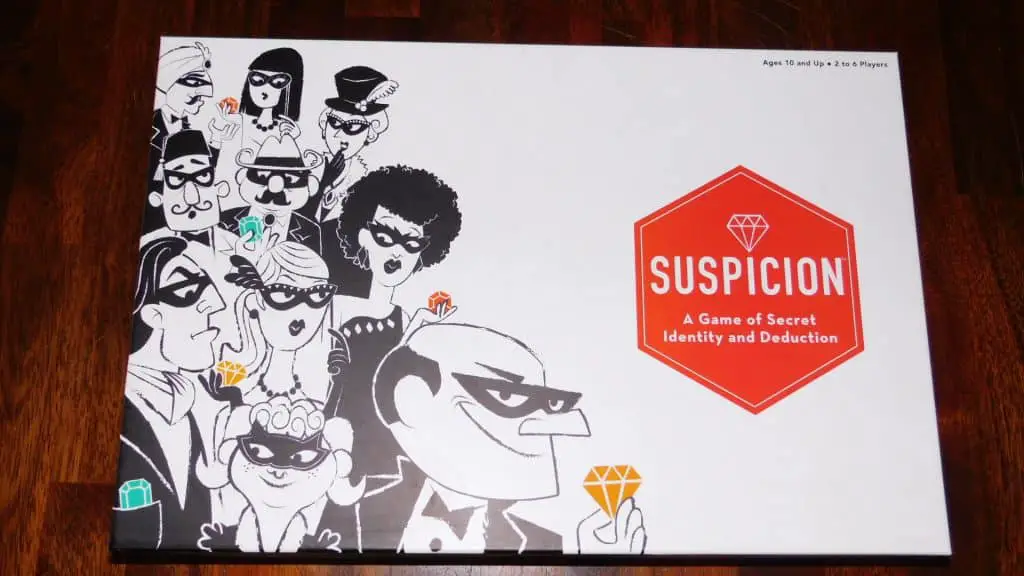
This is the only game on this list of 5 board games like Clue that I haven’t played yet. I do have it though and trust me, I really want to. I actually found out about it while making this list, and I bought it almost immediately.
That happens sometimes. You find a game that just speaks to you on some level, and while Suspicion doesn’t do that on a deep level, like a heavy, thoughtful movie, it does on a light, fun level, like a summer popcorn flick. I’m excited to try this game.
Back-Of-The-Box Facts About Suspicion
- Player Count: 2-6
- Time To Play: 1 hour
- Age Range: 10 and up
- Difficulty: Beginner/Easy
- Price Range: $20-$25
- Release Year: 2016
- Publisher(s): Wonder Forge
- Designer(s): Prospero Hall
- Artist(s): Unknown
A Quick Overview Of How To Play It
Suspicion is about stealing gems and figuring out what characters the other players are controlling. Each gem set you collect by the end of the game (a gem set is 1 diamond, 1 ruby, and 1 emerald) is worth 6 points. Every other gem you have that’s not part of a gem set is worth 1 point. Finally, for every player’s identity you figure out by the end of the game, you get 7 points.
To play, you’re going to roll 2 dice. The dice show the guests in the mansion and each dice also shows a question mark.
When a guest is shown you must move that guest to an adjacent room. If the guest is shown twice, you may move them twice.
The question mark symbol lets you move any guest you want. If you roll 2 question mark symbols, you can either move 2 separate guests or the same guest twice.
Next, you’ll choose one of the 2 action cards in your hand and play it face up. Each card has 2 actions, and you’ll need to perform both, but you can do so in any order you want. The actions will let you take gems, move guests, question the other players about their identities, and look at secret cards.
When your turn is over, let players mark any information they want on their deduction sheet, then play moves to the next player. The game ends when 1 of the 3 stacks of gem tiles (sorted at the beginning of the game) is empty.
Similarities To Clue
The main similarity is that Suspicion uses a deduction sheet to figure out the mysteries of the game. Although there’s no murder in Suspicion like there is in Clue, you still have to figure out what characters belong to what players.
Also, both take place inside mansions, and both involve some form of talking to figure out information. Both also play relatively quickly, taking about an hour.
Differences From Clue
One of the main differences is that Suspicion has a much more minimalist art style than Clue does. Whereas Clue has a painterly quality to its rooms, characters, and cards, Suspicion uses only a few colors and a lot of black and white to showcase its characters, rooms, and cards.
Another difference is the goal of the game. Clue isn’t about points; it’s about figuring out who committed Mr. Boddy’s murder, where, and with what weapon. Suspicion is about getting points through stealing gems and figuring out players’ identities.
In addition, even though both Suspicion and Clue have luck, Suspicion has less of it. In Clue, you can only move as far as the dice let you, and it’s possible to keep rolling low numbers. The secret passages help but every time you enter a room, whether that’s by a dice roll or a secret passage, your turn ends.
It’s also possible for someone to name your character in their guess about the murder, which means your character gets moved to their room, which might be far away from where you want to be.
Suspicion also has a chance that your character keeps getting moved to places you don’t want them to be, but it’s only ever one or two rooms per turn. Plus, no matter what room you’re in, there’s always a chance you can steal gems or figure out other players’ identities. There’s also a card that lets you move wherever you want.
Who Would Like This Game?
Anyone looking for something on the same level of complexity as Clue but with a little more strategy and a different goal would like this game. Suspicion is fairly inexpensive at about $20 to $25, it’s got great components, and it’s really easy to set up and play.
This is one of those games that you would finish playing and then play again. It still has a similar feel to Clue too, but now everyone’s playing against each other as much as they are playing against the game.
Kill Doctor Lucky
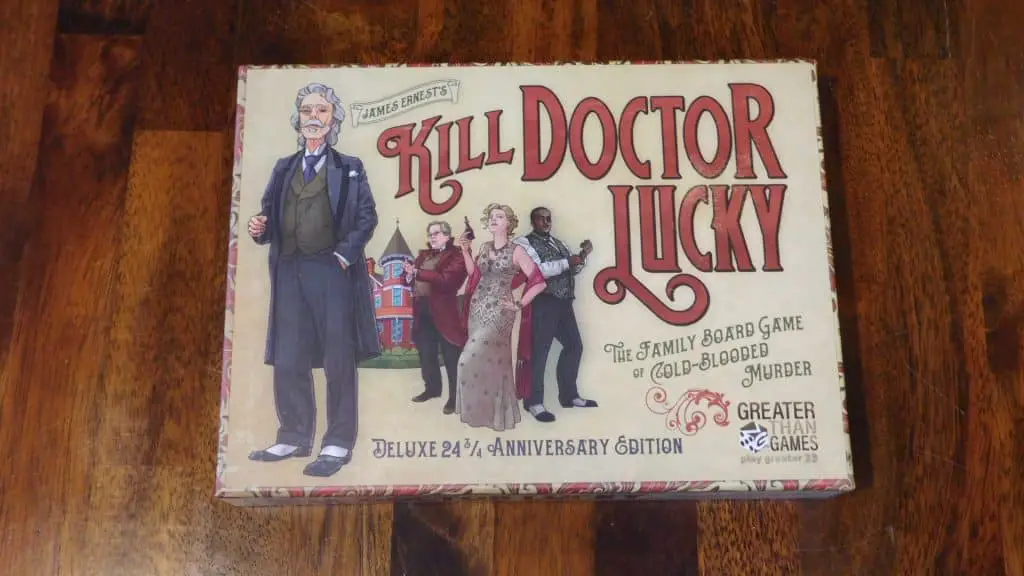
Kill Doctor Lucky has been described as the prequel to Clue. I have played this game before. Years ago, I bought it for a friend whose favorite game is Clue. I mean, they love Clue.
So, I did some research and found out that Kill Doctor Lucky is designed in such a way that it feels like this is the story before the story in Clue starts.
Basically, you’re in a mansion (because why not!), and everyone’s goal is to kill Doctor Lucky. There’s just one problem, he’s really, really lucky when it comes to not dying. So, the whole game turns into this hilarious comedy of errors as this man wanders around the mansion narrowly and obliviously avoiding death while everyone else is trying to kill him.
Even though it’s been a bunch of years since I’ve played this game, I still remember it to this day. I remember where I played it, and who I played it with. I even remember who won.
The game was so memorable that I still remember some of the cards such as the bowl of hard candy that’s been left out for years. Can you tell I liked it? I’m hoping you will too, so let’s get to some quick facts and then how it plays.
Back-Of-The-Box Facts About Kill Doctor Lucky
- Player Count: 3-8
- Time To Play: 30 minutes to 1 hour
- Age Range: 12 and up
- Difficulty: Beginner/Easy
- Price Range: $20-$40
- Release Year: 1996
- Publisher(s): Cheapass Games
- Designer(s): James Ernest
- Artist(s): James Ernest, Israel Evans, and James Ryman
A Quick Overview Of How To Play It
Kill Doctor Lucky is a wonderfully simple game. On a player’s turn, they get to move to any adjacent room for free. Then, if they wish, they can play as many Move cards as they want to move again.
Afterward, if they’re in a room where nobody can see them (including Doctor Lucky), they can draw a card. If they’re alone in a room with Dr. Lucky, and no one else can see you, then you can play a card to try to kill him.
Now, when you play one of these cards, it has a number. How strong your murder attempt is equaled that number plus however much your character’s basic strength is (this starts at 1 and grows by 1 for each failed murder attempt).
After you make your attempt, starting with the player to the left, each player may discard any number of cards to add to Doctor Lucky’s luck. They don’t have to, but they can. Doctor Lucky has no luck himself, so it’s up to the other players to stop the attempted murder.
If the number of clovers on the discarded cards (the clovers are luck) equals or exceeds the murder strength’s attempt, then Doctor Lucky survives. If not, the player who attempted kills Doctor Lucky and wins!
Similarities To Clue
Kill Doctor Lucky is the perfect prequel to Clue. It takes place in a mansion. It also has that old-timey vibe that Clue had for so long, great art, and it centers around a murder. Unfortunately, this is largely where the similarities end with Clue.
Differences From Clue
Kill Doctor Lucky has a lot of differences from Clue. For one, there’s no mystery in Kill Doctor Lucky. You’re just trying to kill him.
For two, there are no dice; everything happens as a result of the cards you play. But this also adds a lot of strategies to Kill Doctor Lucky. There is some luck in the game such as what cards people draw and where people move to interfere with murder attempts, but, for the most part, this is a game about managing and playing your cards well so you can strike at just the right time.
Who Would Like This Game?
Even though Kill Doctor Lucky doesn’t have a ton of similarities with Clue, this is still a great game for those who want something silly and fun (because that’s what murder is, right?), but with a bit more strategy behind it. In fact, of the 5 board games like Clue that I’ve played so far, this one is my favorite.
This is a game that had my friends and me laughing several times. Over time, the game will start to lose some of its lusters as you’ll start seeing the same cards over and over, but this is a game that would be great to break out as a fun filler game at parties or even on holidays.
Scotland Yard
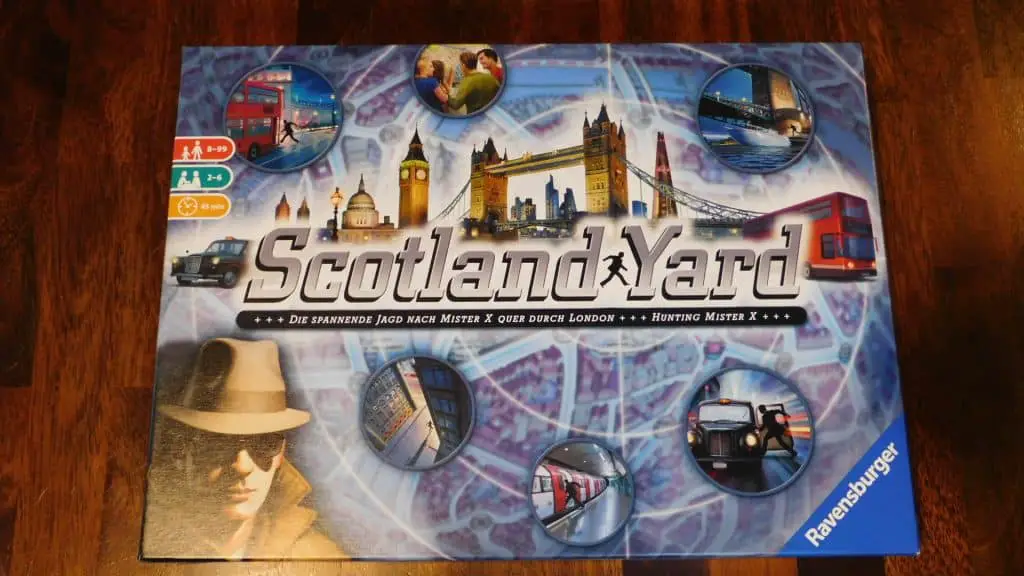
Scotland Yard came out in 1983. Yeah, this game has been around for a long time, and there’s a reason why: it’s a good game. I’ve played this game once before, and although it’s not a game I’m going to buy, it’s still a game I’d play again (more on all of this below).
With that said, let’s get to what it’s all about.
Back-Of-The-Box Facts About Scotland Yard
- Player Count: 3-6
- Time To Play: 1 hour
- Age Range: 10 and up
- Difficulty: Beginner/Easy
- Price Range: $15-$30
- Release Year: 1983
- Publisher(s): Ravensburger
- Designer(s): Manfred Burggraf, Dorothy Garrels, Wolf Hoermann, Fritz Ifland, Werner Scheerer, and Werner Schlegel
- Artist(s): Erika Binz-Blanke, Rene Habermacher, Franz Vohwinkel, Thomas Weiss, Torsten Wolber, and Ugurcan Yüce
A Quick Overview Of How To Play It
Scotland Yard ends when either a detective lands on the spot Mr. X is on, or if Mr. X evades capture for 22 turns. The game can also end if no detective can move because they run out of a certain kind of ticket. This is much rarer but still possible.
Moving Around The Board
Every spot on the board has a number and up to three colors: yellow, blue, and red. Yellow spots can be moved to when you play a yellow ticket, blue spots when you play a blue, and red for red.
Each detective starts with 4 red tickets, 8 blue tickets, and 10 yellow tickets. Mr. X gets 4 yellow tickets, 3 blue tickets, and 3 red tickets. They also get 5 black tickets which can be used as any other color ticket.
To move to a spot, a player plays a ticket that matches one of the colors on that spot. So, if a player wants to move to a spot with a yellow color, they have to be next to that spot and also play a yellow ticket. If a player wants to move to a spot with a blue color, they must start on a spot with a blue color, play a blue ticket, then move to another spot with a blue color.
The same is also true for red. Yellow has the shortest moves, blue has slightly longer moves, and red has the longest moves. Every time a detective uses a ticket, they give it to Mr. X.
Mr. X
Mr. X always goes first though. That player doesn’t have a pawn on the board. Instead, they have a logbook that they keep secret.
On Mr. X’s turn, they spend one of their tickets to move and they secretly mark the number they moved to, then cover it up with the ticket they used. This gives the other players some info as to where Mr. X might be. Also, every few turns, Mr. X has to reveal what number they moved to, which gives the other players even more information!
And that is Scotland Yard in a basic sense!
Similarities To Clue
There’s a ton of deduction in Scotland Yard, which is similar to Clue’s level of deduction. In both, you’re trying to figure out the mystery (unless you’re Mr. X) as best as you can.
Differences From Clue
The main difference between Clue and Scotland Yard is that Clue is a free-for-all whereas Scotland Yard is a 1 versus all game. Scotland Yard also has no dice and could potentially take longer if the detectives or Mr. X are taking their time to strategize. In addition, the mystery keeps changing because Mr. X keeps moving.
Who Would Like This Game?
The reason why I haven’t put Scotland Yard in my collection yet, and the reason why I won’t, is because the game just doesn’t speak to me. Still, it is fun, I would play it again, and it’s still one I’ll happily put on a list of 5 board games like Clue.
In the end, Scotland Yard is going to appeal to people who want to play the game after Clue ends. Whereas Kill Doctor Lucky was the prequel to Clue, Scotland Yard is the sequel. You and your fellow detectives are chasing Mr. X all over London trying to find him.
Like Clue, there’s plenty of deduction here as you and your fellow detectives guess where Mr. X is heading next. This adds a great sense of working together too. So, there’s a good amount of strategy, and it’s fast and easy to play.
The only warning I’ll add is that while I think it would be a good game for families, you will want to be careful if playing with kids. I can easily see them fighting over who gets to be Mr. X.
Spyfall
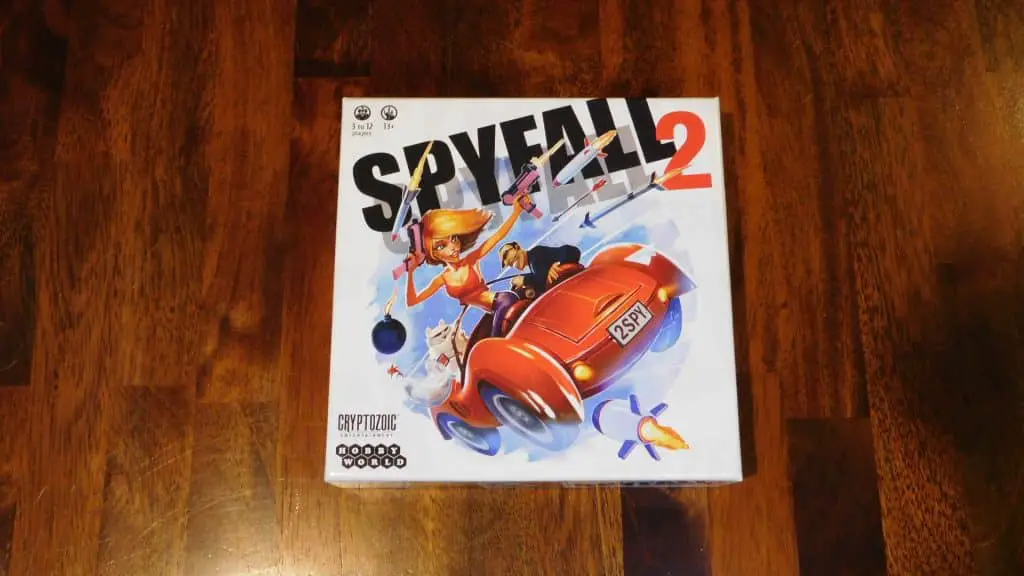
Of the 5 board games like Clue, I have played Spyfall the most. This was several times with a group of friends I don’t get to see anymore. This was many, many years ago now, and similar to Kill Doctor Lucky, I still remember where I played it and who I played it with. I don’t remember who won though, but that might be because we played it more than once.
What I will say upfront is that Spyfall is a game I’d play today. It’s fast and easy, and there are several versions you can choose from (more on that below). I don’t want to give too much away right away though, so let’s get to some quick facts.
Back-Of-The-Box Facts About Spyfall
- Player Count: 3-8
- Time To Play: 10 minutes
- Age Range: 13 and up
- Difficulty: Beginner/Easy
- Price Range: $10-$20
- Release Year: 2014
- Publisher(s): Cryptozoic Entertainment and Hobby World
- Designer(s): Alexandr Ushan
- Artist(s): Sergey Dulin, and Uildrim
A Quick Overview Of How To Play It
Your goal in Spyfall depends on what your role is. So, if you’re the spy, your goal is to not get caught by the time 8 minutes are up (which is when the game ends), or you can stop the game at any time and name the location everyone is in. If you’re wrong about the location, you also lose.
If you’re any other player, your goal is to figure out who the spy is. You can do this either by calling a vote at any time during the game or by voting when the game ends. If the vote correctly identifies the spy, then all other players win. If not, either the game continues as normal or, if the game has ended, then the spy wins.
What Happens On A Player’s Turn
During the game, a player’s turn is simple. You’re going to pick anyone at the table except the last person to ask a question, and you’re going to ask that other person a question.
It’s important to know at this point that everyone around the table has a card only they can see. Every single one of those cards shows the same location except for one of them. That one card shows the spy, who won’t know what the location is, but this is where the game gets interesting.
When you ask another player a question, you want to ask it in such a way that you get information about whether or not they know where the location is without giving away what the location is because the spy could figure it out and win. Once the player answers the question, then they get to ask anyone else a question except you since you just asked them one.
Play continues like this until either the spy is identified, the spy identifies the location, or the 8 minutes run out in which case the players have to vote on who the spy is.
Similarities To Clue
The biggest difference between Clue and Spyfall is that both involve some form of deduction. Whereas in Clue you’re trying to figure out who committed a murder, with what weapon, and where, in Spyfall you’re either trying to figure out the location if you’re the spy or who the spy is if you’re anyone else. This is also where the similarities end.
Differences From Clue
Spyfall plays much faster than Clue, much, much faster. Also, there’s no guessing of rooms or murder weapons or even suspects, it’s just trying to figure out which player is the spy. You’ll only ever have one card in your hand, and that’s going to be either the Spy card or one of the Location cards.
Plus, the only actions you’re ever going to take are going to be asking a question, calling a vote, or identifying the location. These games are pretty different from each other.
Who Would Like This Game?
I’m going to start this section by saying who wouldn’t like this game, and that’s going to be people who suffer from what’s called analysis paralysis and people who aren’t good at or don’t like lying.
Starting with the first group, analysis paralysis refers to someone who has trouble making decisions in games and takes a long time to do so. Games like Spyfall are difficult for them because they sit there and try to think up the perfect question every time, and that’s hard!
For the second group, Spyfall depends on your ability to lie well if you’re the spy, and some people (like me) just aren’t good at it. Either they fold under pressure or they’re not quick on their feet. There’s nothing wrong with this per see, it’s just that they’re going to struggle more with games like Spyfall.
Still, Spyfall is a great party game because it only ever takes at most 8 minutes to play, plays up to 8 players, and there are currently 4 versions of the game: Spyfall, Spyfall 2, DC Spyfall, and Spyfall: Time Travel.
The best groups to play this with would be people who won’t take the game too seriously and are at least a little decent at lying. If you have that group or something close to it, there are a lot of laughs to be had here.
And, even if you aren’t a great liar, like me, you can still have a lot of fun with this game too. The best thing I can recommend is to see what other people who are better at lying do and then put your spin on it. See what happens.
Other Versions Of Clue
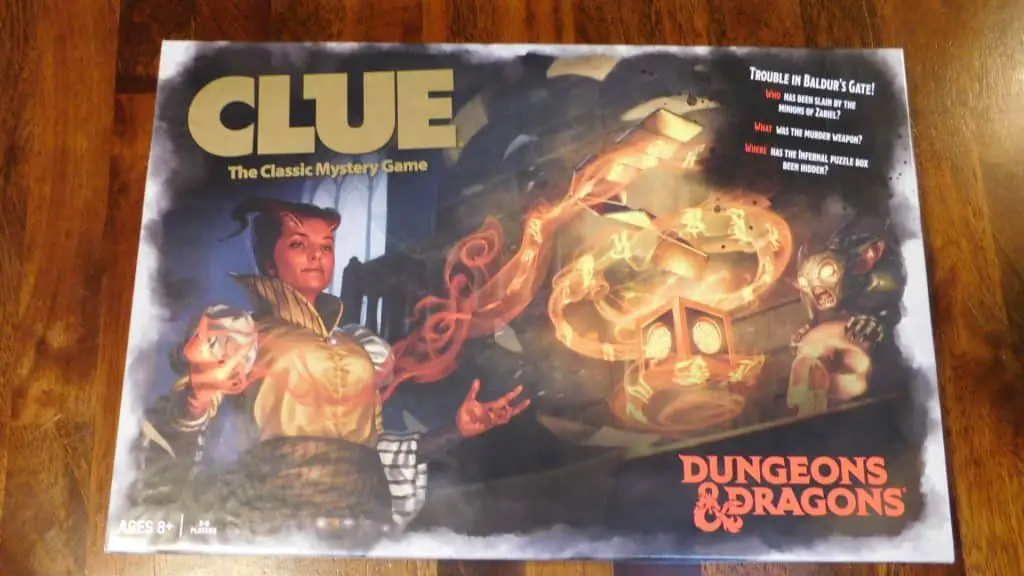
There are lots of versions of Clue. I did a quick check and found over 50 versions of the game, and that was hardly even all of them. I’m mentioning this now because many of them will play a little differently, so when I go over the quick overview below, please know I’m just going over the most basic rules of the most basic version of the game.
Also, I realize this article is titled, “5 board games like Clue,” and this adds a whole lot more to the list, but I think it’s okay to list all these games as one entry on this list since they’re all twists on the Clue formula anyway.
Back-Of-The-Box Facts About Clue
- Player Count: 2-6
- Time To Play: 30 minutes to 1 hour
- Age Range: 8 and up
- Difficulty: Beginner/Easy
- Price Range: $10-$20
- Release Year: 2018
- Publisher(s): Hasbro
- Designer(s): Unknown
- Artist(s): Unknown
I chose to include only the back-of-the-box facts for regular Clue since there are too many versions to include back-of-the-box facts for here. That said, most of the important back-of-the-box facts will stay the same such as player count, time to play, age range, difficulty, and price. Enjoy!
A Quick Overview Of How To Play Them
In Clue, your goal is to figure out who killed Mr. Boddy, where they did it, and with what weapon. To do so, you’re going to move into or stay in rooms and make guesses to get information.
Movement
In more detail, the first thing you’ll do is choose to either move, stay in the current room, or use a secret passage. If you choose to move, you’re going to roll the two dice that come with the game.
Whatever combined number the two dice give you is how many spaces you can move. If your movement puts you in a room, your turn is over immediately.
If you choose to stay in a room you simply stay there; if you choose to use a secret passage (these are marked on the game board), you move to the room the secret passage is connected to and your turn is over.
Making A Suggestion
Once in a room (whether by moving there, staying there, or using a secret passage to get there), you can make a suggestion or an accusation. The difference is that a suggestion has no penalty if you get it wrong, but if you get an accusation wrong, you lose the game.
When making a suggestion, you must name the room you’re in, any character, and any weapon. Whatever character and weapon you name must be moved into the room you’re in.
Starting with the player to your left, each player has a chance to secretly show you a card of their choice that matches one of the things you named. If they can’t, the next player in line has a chance, and so on. If a player can show you such a card, you secretly mark it down on the information sheet that comes with the game.
How To Win/How The Game Ends – Making An Accusation
Whether they do or don’t, you can make an accusation. With an accusation, you still name a room, character, and weapon, but the room doesn’t have to be the one you’re in. You check the three cards set aside at the beginning of the game. If you’re right, you win. If not, you lose.
Similarities To Clue
There’s not much to say here as most versions will use the same basic rules as described above. I haven’t played most versions of Clue, so I can only guess at that, but from what I’ve seen that seems to be the case.
Differences From Clue
This will depend on each version. For example, the Dungeons & Dragons version has an optional deck called the Wandering Monsters deck. If a player lands on a claw-marked space on the board, they draw the top card from the deck and fight the monster it reveals.
They fight the monster by rolling a die. If they win, they get a magic item. If they lose, they go to the center of the board, which means they’ll have to make some rolls to move back to a room.
Who Would Like These Games?
Anyone who wants to keep playing Clue but wants a different version would like these games. Not every version is for every person, but there’s probably one you’ll enjoy if you like base Clue.
There are tons of versions, including:
- Clue: The Office Edition
- Clue: 1986 Edition
- Clue: Disney Villains Edition
- Clue: Dexter Edition
- Clue: IT Edition
- Clue: Harry Potter Edition
- Clue: Bob’s Burgers Edition
- Clue: Junior Edition
- Clue: Scooby Doo! Edition
- Clue: Dungeons & Dragons Edition
- Clue: Master Detective Edition
- Clue: Firefly Edition
These are just some of the editions of Clue. If you’re looking for a version of the game that takes place in a certain piece of popular media (like a movie, TV show, etc.) then it probably exists or will soon.
Did You Know?
(Each time you refresh the page you will get a new “Did You Know” fact!)
Did you know that making board game nights work when kids are there is easy and fun? Well, if you’re interested in some tips, head on over here!
Conclusion: 5 Board Games Like Clue
There are many more board games than 5 similar to Clue, which we’ll try to cover in other posts. For now, these are a good set that should give you lots of fun times.
So, which of these games are you most excited to try first and why? Which one are you not interested in at all and why? What 5 board games like Clue did we forget and why should they be included?
Let us know in the comments below!
And, as always, keep on gaming, fellow maniacs.
